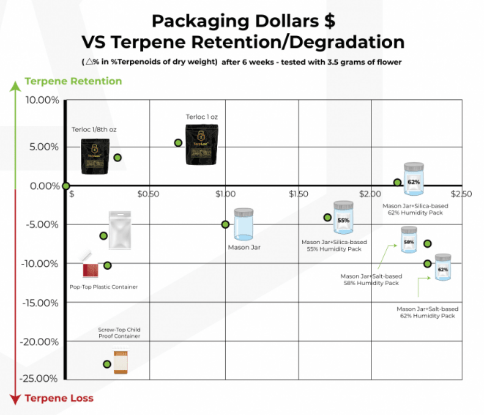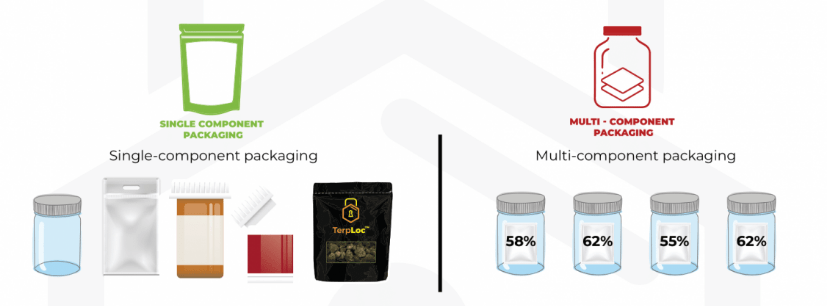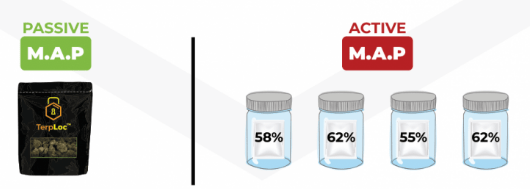This website uses cookies so that we can provide you with the best user experience possible. Cookie information is stored in your browser and performs functions such as recognising you when you return to our website and helping our team to understand which sections of the website you find most interesting and useful.
The Science of TerpLoc
Terpene Results
The Grove Bags 1 oz pouch had the highest overall terpene and cannabinoid retention, which was determined by comparing the totals for average terpenoids and average Max THC (Max THC= (THCa x .877) + THC). The levels of terpenes present were up to 36.72% higher and Max THC was up to 7.25% higher in the herb stored in the Grove Bags 1 oz pouch.

Most Efficient Single Component Curing And Storage Solution
Compared to the field, TerpLoc® is the only single component storage solution that allows you to retain up to 36% more terpenes over time for a fraction of the cost of multi component solutions. One of the questions that we often receive is how the terpene content consistently remains higher for flower stored in TerpLoc® products. This is due to the fact that the TerpLoc® film has been fine tuned to create the perfect microclimate for herb preservation. Terpene molecules will degrade with either too much or too little moisture, so the perfect preservation climate requires a relative humidity level between 58-62%. Traditionally this was achieved by manually burping each package at the beginning of the curing phase until ideal moisture levels were met. Burping flushes out the headspace to get rid of excess water vapor and anything off-gassing from the plant. With TerpLoc® products all unwanted water vapor and gases are diffused through the layers of the package removing the need to burp. This will drastically cut down on labor costs and provide more consistency throughout the product by eliminating human error.

Single Component vs Multi Component Packaging
Single Component packaging are packaging solutions that only require a single element, for example, a bag, a jar. Multi Component packaging requires more than one element, for example, a jar with a humidity pack. Of course, since 2 is greater than 1, the pricing for the multi component packaging are almost always more expensive. In addition, with 2 or more components, additional risks are also added, such as a leak or breakage in the humidity pack. More labor is also needed for transporting and adding the humidity pack to the final package.

Passive vs Active Modified Atmospheric Packaging
Modified Atmospheric Packaging (MAP) refers to a type of packaging solution that can regulate the internal atmosphere of the package to increase the shelf life of the stored materials.
Passive MAP refers to specialized packaging with unique materials that allows the desired internal atmospheric condition to develop naturally as a result of the packaged product’s respiration and gas diffusion through the barrier.
Active MAP refers to any packaging that has a process of artificially displacing the gas within the package which is then replaced and/or supplemented by the desired atmospheric composition. A package/packaging process that includes Nitrogen/Argon/other noble gas flushing would be considered Active MAP. Just as a mason jar with a humidity pack would be as well.
Terploc® is the 1st and most effective Passive MAP on the market place. Compared with Active MAP, Terploc’s Passive MAP there’s less packaging breakage risk, less labor required, less shipping worries, and most of all, more Terpenes!


